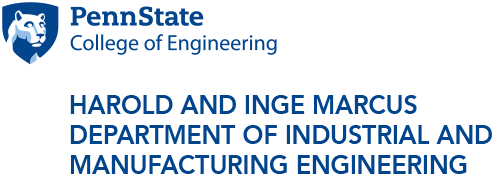
Scarlett Miller (right), assistant professor, demonstrates how a surgical resident would use the haptic robotic training. Jason Moore (center), assistant professor, and Inki Kim (left), doctoral candidate, watch the screen that displays the robot's trajectory.
NIH grant will support central venous catheter insertion training
3/27/2015
UNIVERSITY PARK, Pa. — Scarlett Miller, assistant professor in the School of Engineering Design, Technology and Professional Programs and the Harold and Inge Marcus Department of Industrial and Manufacturing Engineering, and Jason Moore, assistant professor in the Department of Mechanical and Nuclear Engineering, were awarded a Research Project Grant (R01) of $698,178 from the National Institutes of Health’s (NIH) National Heart, Lung and Blood Institute.
Miller and Moore are co-principal investigators on the three-year project titled, “Dynamic Haptic Robotic Training for Central Venous Catheter Insertion.”
The goal of the research project is to develop, test and implement an innovative new training method that uses a programmable robot to apply force to a surgical resident’s hand in order to mimic how it feels when inserting a needle into a patient. Miller and Moore believe this system will improve the efficiency of residents in performing central venous catheter (CVC) insertions and will help build their skills and confidence before carrying out these interventions on patients.
“More than 5 million CVC procedures are performed in the United States annually; however up to 39 percent of CVC patients experience some type of complication,” said Miller. “We are hoping that our research will ultimately lead to better outcomes for both surgical residents and their patients.”
Miller explained that traditionally surgical residents have learned to insert CVCs by inserting a needle into the chest of a human replica and relying on ultrasound images to guide the catheter into place. However, this is a difficult procedure to master and often leads to complications for the patients and stress on the residents once they are in a surgical setting.
“There is a dire need for identifying the ideal methodology for training residents on CVC procedures in order to develop standards and reduce adverse medical events,” said Miller.
The three focuses of the grant are: to develop an accurate needle insertion model that will be programmed into the robotic device to simulate the feel of haptic needle insertion; to develop and optimize training for using the device; and to assess long-term improvements in inserting central venous catheters and the effects on patient safety after incorporating this new system in the educational curricula at Penn State Milton S. Hershey Medical Center.
By using a programmable robot instead of a static replica, residents can train for a more diverse range of settings. For example, the program could account for the differences patient weights or tissue densities that would be encountered in real world procedures.
Additionally, the program will assess the current skill level of the resident during the CVC insertion procedure and automatically adjust the training curricula based on this knowledge.
“That’s the dynamic part of it,” Moore said. “It’s interactive so residents can be adequately trained in areas where they are not naturally strong.”
Miller and Moore, along with industrial engineering doctoral candidate Inki Kim and mechanical engineering and Schreyer Honors College undergraduate student Adam Gordon, have been researching this issue for the last two years with guidance and input provided by David Han, the vice chair of education in the Department of Surgery and the director of General Surgery Residency Program at the Penn State Hershey Heart and Vascular Institute.
The researchers observed 18 surgical residents during their CVC training sessions in the summer of 2013 to determine the types of errors being made and used this knowledge to develop key design criteria for their robotic trainer.
Moore has extensively studied haptic robotics and the interaction between medical instruments and soft tissue inside the body. Miller has studied effective learning techniques for medical resident training, and has developed medical tools and visualizations that reduce injuries and increase efficiency in the surgical suite.
The NIH grant allows Miller and Moore to advance their work beyond the preliminary stages and launch into a three-year study that looks at how surgical students perform with this training program.
“We are excited that we will be able to implement this training program at the Penn State Hershey Medical Center, assess how surgical residents perform and improve their learning,” Moore said.
The R01 grant provides support for health-related research and development based on the mission of the NIH and has an excellent possibility for refunding.




